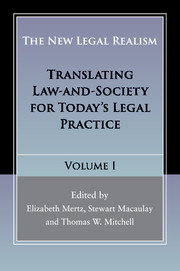Book contents
- Frontmatter
- Contents
- List of contributors
- Preface to The New Legal Realism, Volumes I and II
- 1 Introduction: New Legal Realism: Law and Social Science in the New Millennium
- Section I THE PLACE OF NEW LEGAL REALISM IN LEGAL THOUGHT AND TEACHING
- Section II PHILOSOPHY AND METHODS FOR A NEW LEGAL REALISM
- 6 Legal R/realism and Jurisprudence: Ten Theses
- 7 Legal Realism in Context
- 8 Legal Storytelling as a Variety of Legal Realism
- 9 Combining Methods for a New Synthesis in Law and Empirical Research
- Section III NEW LEGAL REALIST TRANSLATIONS
- Index
- References
7 - Legal Realism in Context
from Section II - PHILOSOPHY AND METHODS FOR A NEW LEGAL REALISM
Published online by Cambridge University Press: 05 May 2016
- Frontmatter
- Contents
- List of contributors
- Preface to The New Legal Realism, Volumes I and II
- 1 Introduction: New Legal Realism: Law and Social Science in the New Millennium
- Section I THE PLACE OF NEW LEGAL REALISM IN LEGAL THOUGHT AND TEACHING
- Section II PHILOSOPHY AND METHODS FOR A NEW LEGAL REALISM
- 6 Legal R/realism and Jurisprudence: Ten Theses
- 7 Legal Realism in Context
- 8 Legal Storytelling as a Variety of Legal Realism
- 9 Combining Methods for a New Synthesis in Law and Empirical Research
- Section III NEW LEGAL REALIST TRANSLATIONS
- Index
- References
Summary
“We are all realists now,” it is frequently said, yet what legal realism was about remains vigorously debated. When tackling this question, it is common to begin by identifying who counts as legal realists and then identifying what they purportedly believed in. Convention has Oliver Wendell Holmes, Jr., John Chipman Gray, Roscoe Pound, and Benjamin Cardozo as antecedents of realism; core realists typically include Karl Llewellyn, Jerome Frank, Felix S. Cohen, Walter Wheeler Cook, Herman Oliphant, Underhill Moore, Hessel Yntema, Charles Clark, Wesley Sturges, William O. Douglas, Leon Green, Max Radin, Thurman W. Arnold, and Joseph C. Hutcheson. Standard accounts of what they stood for are: the legal realists were anti-formalists. They denied that legal rules determined judicial decisions. They saw law as a means to social ends. They advocated a functional view that urges attention to what law actually does. They promoted the application of social science to law. They were rebellious critics of the legal establishment. They denied the claimed neutrality of law. They were New Dealers. What helps keep the dispute alive is that the figures identified as core realists did not all espouse the same positions on these matters.
In this essay I will argue that there is a better way to understand realism, which decenters the core legal realists and what they purportedly believed in. We should see realism instead as a complex of perspectives that characterized a new age of thinking about law. Because the legal realists were not unique in holding these views, I argue, it is a mistake to think that the key to understanding realism can be found through a close examination of their particular positions, especially since they disagreed amongst themselves a great deal. To establish this I will alternate between two contexts: the narrow context of the Llewellyn-Pound exchange, which first brought attention to “legal realism,” and the broad context of widely expressed realistic views in the generation preceding this exchange.
The diversity of views among the named legal realists is often suppressed by jurists who tell us what legal realism was about, but Karl Llewellyn emphasized this at the beginning, the middle, and the final words of his essay clarifying realism.
- Type
- Chapter
- Information
- The New Legal RealismTranslating Law-and-Society for Today's Legal Practice, pp. 147 - 168Publisher: Cambridge University PressPrint publication year: 2016
References
- 1
- Cited by



